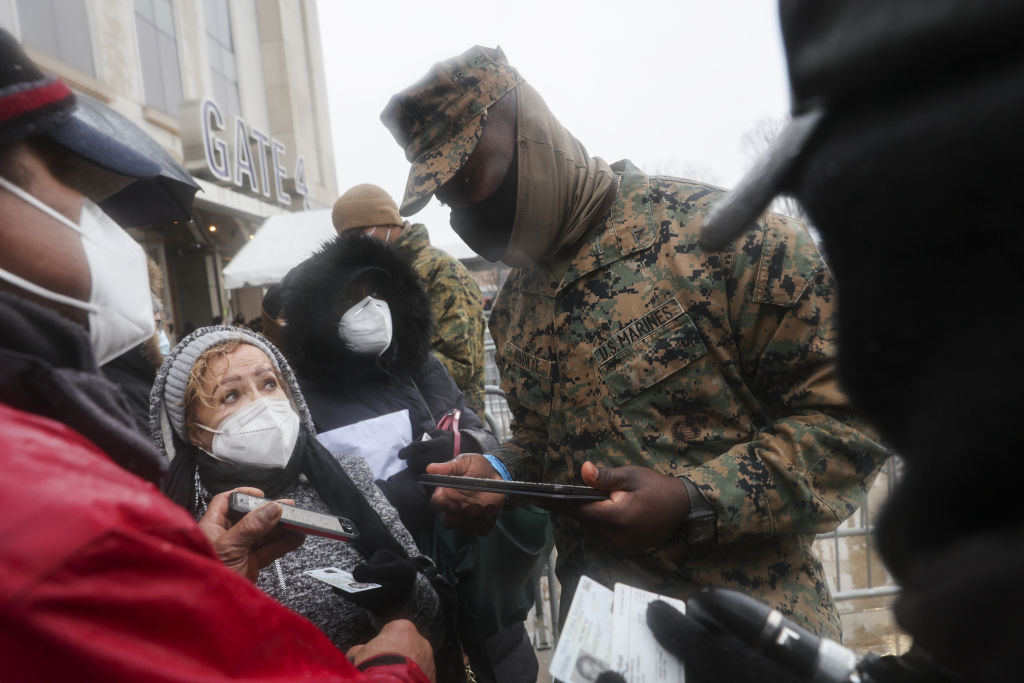
Making good on President Joe Biden’s promises for additional U.S. military support in the national fight against COVID-19, the Pentagon committed for the first time to deploy teams of active-duty service members to support mass vaccination centers.
On Friday, Defense Secretary Lloyd Austin approved a request to deploy 1,110 troops across the country to help combat the deadly disease with the Federal Emergency Management Agency (FEMA). There will be a total of five teams, each comprising 222 personnel, including nurses, vaccinators and clinical staff.
The move marks a significant change from the Trump Administration, which was reluctant to use the armed forces in vaccine delivery and administration, opting instead to rely on private industry. The slow pace of vaccinations, though, prompted Biden to arrange a more muscular federal response, ordering FEMA and the Pentagon to team up and establish 100 mass vaccination centers within a month.
White House coronavirus adviser Andy Slavitt said in a briefing that two of the centers are opening in California, and troops will arrive at the sites within the next 10 days. “The military’s critical role in supporting sites will help vaccinate thousands of people per day, and ensure that every American who wants a vaccine will receive one,” Slavitt said.
The government-led effort to develop and test COVID-19 shots stands as a record-setting feat that reduced standard vaccine development time from 10 years to under one. But the ambitious effort has hit a speed bump in the distribution and injection phases throughout the country. For instance, more than 57 million vaccine doses have been distributed, but just 35 million doses have been administered as of Feb.4, according to the Centers for Disease Control and Prevention.
The COVID-19 vaccines authorized so far, from Pfizer-BioNTech and Moderna, each require two shots spaced about a month apart. Only about 6.9 million Americans have received both required doses to become fully inoculated, which roughly translates to 2% of the U.S. population. Meanwhile, there are currently 26 million confirmed COVID-19 cases in the U.S. with nearly 456,000 deaths, which is the largest toll of any nation.
From the beginning of the COVID-19 outbreak, the military has supported the Department of Health and Human Services in a range of missions from building emergency hospitals to overseeing vaccine logistics. But thus far the military has not gotten into the last phase of the multifaceted inoculation campaign.
The U.S. military has a long history of responding to natural disasters in the U.S. and overseas, which tend to strike a single region. The coronavirus pandemic is ravaging the U.S. in waves, hitting all 50 states, with multiple major outbreaks.
The Biden Administration also announced plans to invoke use the Defense Production Act (DPA) to mobilize U.S. private production capacity to manufacture the supplies for at-home virus tests, surgical gloves and Pfizer-BioNTech’s vaccine. Initially signed into law by President Harry Truman in 1950 in response to the Korean War, the DPA is historically based on the War Powers Acts of World War II. Its sweeping authorities allow the president to demand businesses and corporations to prioritize and accept government contracts for materials during natural disasters, terrorist attacks and other national emergencies.
More Must-Reads from TIME
- Cybersecurity Experts Are Sounding the Alarm on DOGE
- Meet the 2025 Women of the Year
- The Harsh Truth About Disability Inclusion
- Why Do More Young Adults Have Cancer?
- Colman Domingo Leads With Radical Love
- How to Get Better at Doing Things Alone
- Michelle Zauner Stares Down the Darkness
Write to W.J. Hennigan at william.hennigan@time.com